The AMD 3rd Gen Ryzen Deep Dive Review: 3700X and 3900X Raising The Bar
by Andrei Frumusanu & Gavin Bonshor on July 7, 2019 9:00 AM EST** = Old results marked were performed with the original BIOS & boost behaviour as published on 7/7.
Benchmarking Performance: CPU System Tests
Our System Test section focuses significantly on real-world testing, user experience, with a slight nod to throughput. In this section we cover application loading time, image processing, simple scientific physics, emulation, neural simulation, optimized compute, and 3D model development, with a combination of readily available and custom software. For some of these tests, the bigger suites such as PCMark do cover them (we publish those values in our office section), although multiple perspectives is always beneficial. In all our tests we will explain in-depth what is being tested, and how we are testing.
All of our benchmark results can also be found in our benchmark engine, Bench.
Application Load: GIMP 2.10.4
One of the most important aspects about user experience and workflow is how fast does a system respond. A good test of this is to see how long it takes for an application to load. Most applications these days, when on an SSD, load fairly instantly, however some office tools require asset pre-loading before being available. Most operating systems employ caching as well, so when certain software is loaded repeatedly (web browser, office tools), then can be initialized much quicker.
In our last suite, we tested how long it took to load a large PDF in Adobe Acrobat. Unfortunately this test was a nightmare to program for, and didn’t transfer over to Win10 RS3 easily. In the meantime we discovered an application that can automate this test, and we put it up against GIMP, a popular free open-source online photo editing tool, and the major alternative to Adobe Photoshop. We set it to load a large 50MB design template, and perform the load 10 times with 10 seconds in-between each. Due to caching, the first 3-5 results are often slower than the rest, and time to cache can be inconsistent, we take the average of the last five results to show CPU processing on cached loading.
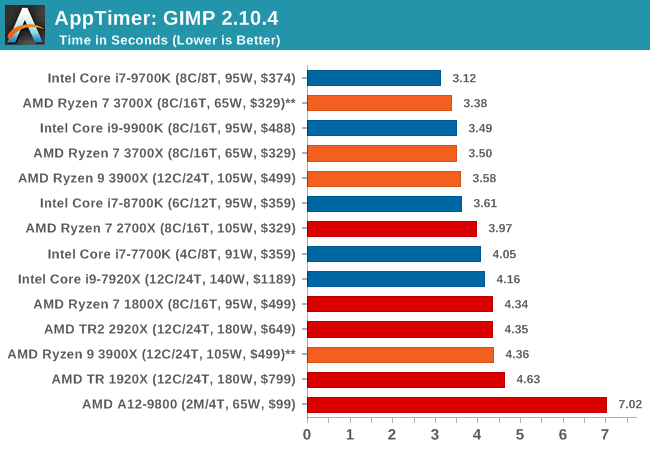
Application loading is typically single thread limited, but we see here that at some point it also becomes core-resource limited. Having access to more resources per thread in a non-HT environment helps the 8C/8T and 6C/6T processors get ahead of both of the 5.0 GHz parts in our testing.
3D Particle Movement v2.1: Brownian Motion
Our 3DPM test is a custom built benchmark designed to simulate six different particle movement algorithms of points in a 3D space. The algorithms were developed as part of my PhD., and while ultimately perform best on a GPU, provide a good idea on how instruction streams are interpreted by different microarchitectures.
A key part of the algorithms is the random number generation – we use relatively fast generation which ends up implementing dependency chains in the code. The upgrade over the naïve first version of this code solved for false sharing in the caches, a major bottleneck. We are also looking at AVX2 and AVX512 versions of this benchmark for future reviews.
For this test, we run a stock particle set over the six algorithms for 20 seconds apiece, with 10 second pauses, and report the total rate of particle movement, in millions of operations (movements) per second. We have a non-AVX version and an AVX version, with the latter implementing AVX512 and AVX2 where possible.
3DPM v2.1 can be downloaded from our server: 3DPMv2.1.rar (13.0 MB)
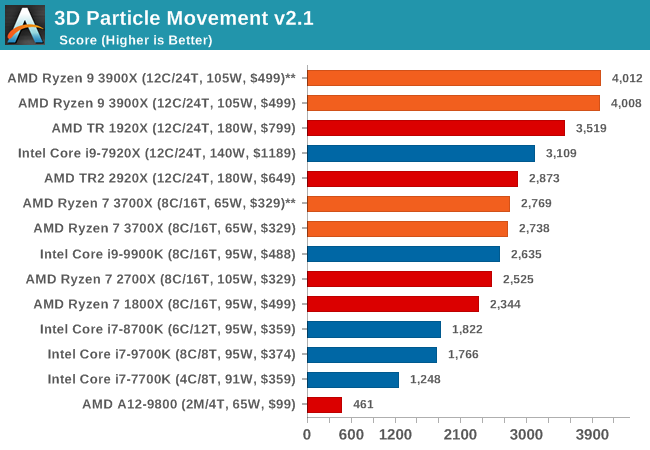
With a non-AVX code base, the 9900K shows the IPC and frequency improvements over the R7 2700X, although in reality it is not as big of a percentage jump as you might imagine. The processors without HT get pushed back a bit here.

Dolphin 5.0: Console Emulation
One of the popular requested tests in our suite is to do with console emulation. Being able to pick up a game from an older system and run it as expected depends on the overhead of the emulator: it takes a significantly more powerful x86 system to be able to accurately emulate an older non-x86 console, especially if code for that console was made to abuse certain physical bugs in the hardware.
For our test, we use the popular Dolphin emulation software, and run a compute project through it to determine how close to a standard console system our processors can emulate. In this test, a Nintendo Wii would take around 1050 seconds.
The latest version of Dolphin can be downloaded from https://dolphin-emu.org/
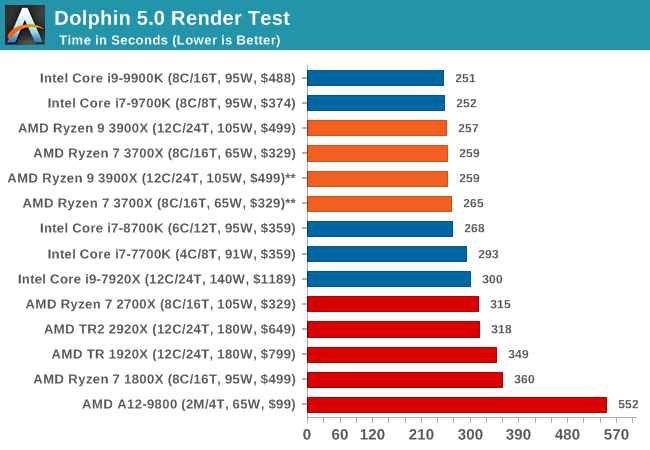
DigiCortex 1.20: Sea Slug Brain Simulation
This benchmark was originally designed for simulation and visualization of neuron and synapse activity, as is commonly found in the brain. The software comes with a variety of benchmark modes, and we take the small benchmark which runs a 32k neuron / 1.8B synapse simulation, equivalent to a Sea Slug.
Example of a 2.1B neuron simulation
We report the results as the ability to simulate the data as a fraction of real-time, so anything above a ‘one’ is suitable for real-time work. Out of the two modes, a ‘non-firing’ mode which is DRAM heavy and a ‘firing’ mode which has CPU work, we choose the latter. Despite this, the benchmark is still affected by DRAM speed a fair amount.
DigiCortex can be downloaded from http://www.digicortex.net/
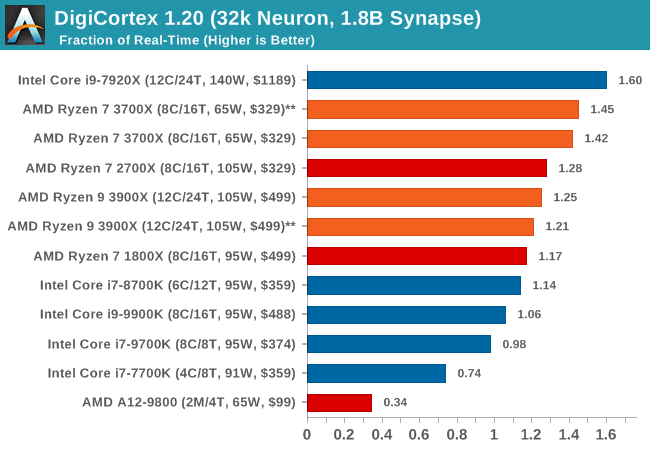
y-Cruncher v0.7.6: Microarchitecture Optimized Compute
I’ve known about y-Cruncher for a while, as a tool to help compute various mathematical constants, but it wasn’t until I began talking with its developer, Alex Yee, a researcher from NWU and now software optimization developer, that I realized that he has optimized the software like crazy to get the best performance. Naturally, any simulation that can take 20+ days can benefit from a 1% performance increase! Alex started y-cruncher as a high-school project, but it is now at a state where Alex is keeping it up to date to take advantage of the latest instruction sets before they are even made available in hardware.
For our test we run y-cruncher v0.7.6 through all the different optimized variants of the binary, single threaded and multi-threaded, including the AVX-512 optimized binaries. The test is to calculate 250m digits of Pi, and we use the single threaded and multi-threaded versions of this test.
Users can download y-cruncher from Alex’s website: http://www.numberworld.org/y-cruncher/

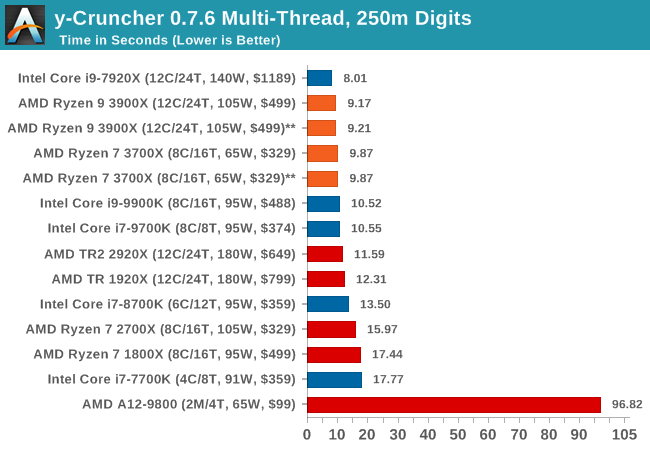
Agisoft Photoscan 1.3.3: 2D Image to 3D Model Conversion
One of the ISVs that we have worked with for a number of years is Agisoft, who develop software called PhotoScan that transforms a number of 2D images into a 3D model. This is an important tool in model development and archiving, and relies on a number of single threaded and multi-threaded algorithms to go from one side of the computation to the other.
In our test, we use version 1.3.3 of the software with a good sized data set of 84 x 18 megapixel photos, and push it through a reasonably fast variant of the algorithms. We report the total time to complete the process.
Agisoft’s Photoscan website can be found here: http://www.agisoft.com/
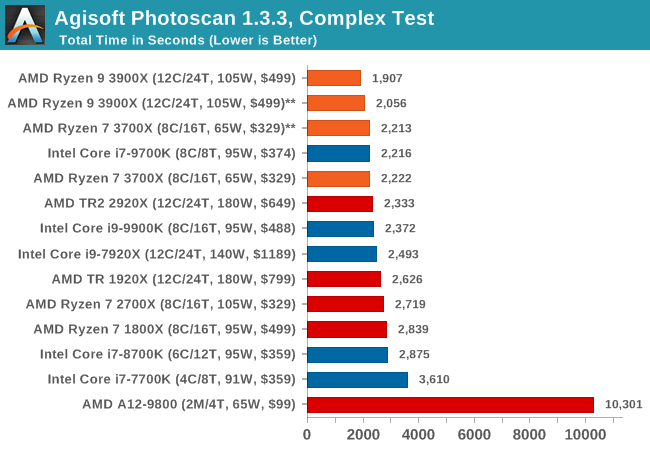












447 Comments
View All Comments
Tkan215 - Monday, July 8, 2019 - link
true the future is more cores. People and customers should feel awake that single core aint the future its just a stopping rock. more cores !Tkan215 - Monday, July 8, 2019 - link
yes i called it a tie because of the margin of error and patches were not taken into account. also, Intel get enormouse game support so really many factors as they are not equal playing groundwatzupken - Sunday, July 7, 2019 - link
Intel's bad moment just started. Clearly while there are some areas where Intel chips are still doing well, however the victories are significantly lesser now. Looking at the power metrics, they lost the fab advantage, so they are now in the disadvantage. To top it off, Intel is still charging monopolistic prices on their existing chips. Have not really seen the rumored price cuts, which may be too little and too late.StrangerGuy - Sunday, July 7, 2019 - link
IMO the $200 CPU landscape is now buy 3600 non-X, or get ripped off by Intel anything even if the latter for cheaper by $50.mikato - Thursday, July 11, 2019 - link
Yeah I really wish a 3600 was tested.Maxiking - Sunday, July 7, 2019 - link
Intel is waiting for 10nm, considering the fact AMD didn't even match Skylake prepatches performance... IF Intel fixes the 10nm, AMD will be be smashed to the ground. If it is a big if, but it is a fact.Mahigan - Sunday, July 7, 2019 - link
AMD actually beat Intel on a clock for clock basis now. What you're seeing is Intel's higher boost clocks saving the day (somewhat).If Intel can't go past 5GHz with their 10nm, due to the new core design, and only are able to get say 10-15% more performance per clock then Gen3 Ryzen will most likely end up, with its 7nm+ and improvements AMD aren't done making, in tough competition.
just4U - Sunday, July 7, 2019 - link
Intel won't be doing any smashing anytime soon there Max.. I was damn pleased with the overall value/performance of my 2700x in comparison to my highly overclocked 8700K (4.9Ghz) and basically shrugged of the 9 series intel. The addition of a 12core.. with great performance levels really changes the game.Even if Intel brings something out it's not going to destroy anything. All we've seen over the past 5 years is small bumps upwards in performance.
Korguz - Sunday, July 7, 2019 - link
Maxiking intel has been waiting for 10nm for 204 years now.. and they are still kind of waiting for it. skylake prepatch ? as in specture and meltdown ? um.. kind of need those fixes/patches in place, even if it means a performance hit.. but by all means.. get skylake, dont fix/patch it, and worry about that.. and spend more.. its up to you... either way.. zen2.. looks very good....Targon - Monday, July 8, 2019 - link
What RAM was used in the Intel system? The Ryzen system used DDR4-3200, but it's CL16, not CL14 RAM. That CAS latency difference would be enough for Ryzen to at least tie the 9900k if not beat it in the gaming tests.